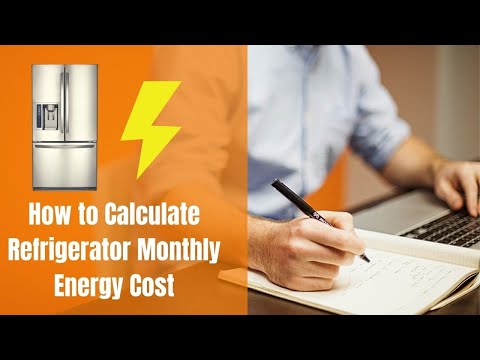Want to know how much does it cost to run a refrigerator? We’re here to help. We’ll cover the costs and offer some energy-saving tips.
- Understanding your refrigerator’s energy use.
- How to calculate the cost of running your refrigerator?
- Energy-saving tips to lower your bill.
This information can help you save on your energy bill. If you’re interested in saving money or reducing your carbon footprint, this guide is for you. Let’s get started.
Table Of Contents
- Understanding the Energy Consumption of Your Fridge
- Calculating the Cost of Running Your Refrigerator
- Tips to Reduce Your Refrigerator’s Energy Consumption
- Smart Technology: The Future of Energy-Efficient Refrigeration
- Knowing the Energy Star Rating and What It Means for Your Fridge
- Frequently Asked Questions

Understanding the Energy Consumption of Your Fridge
Understanding your refrigerator’s energy usage involves considering its model, size, and settings. Let’s simplify how these factors affect the electricity consumption of your fridge.
Estimating Your Fridge’s Energy Consumption
To estimate your refrigerator’s energy consumption, you can use its wattage and the number of hours it is in use each day. This formula can guide you:
Energy Consumption = Wattage x Hours used per day ÷ 1000 = Daily kilowatt-hour (kWh) usage.
This is only an estimate. Your actual energy use might depend on your habits and refrigerator model. Consider your local energy rates for cost calculation.
Understanding your refrigerator’s energy use can guide your usage or upgrade decisions. Lower energy use reduces greenhouse gas emissions, promoting a healthier planet.
Calculating the Cost of Running Your Refrigerator
Estimating the yearly cost of your refrigerator’s operation might seem challenging. However, with basic principles and simple math, it’s actually quite straightforward.
Note: Actual costs can vary based on factors such as refrigerator age, model, size, usage habits, and temperature settings.
Example: Your fridge uses 500 kWh annually, and the electricity rate is 12 ¢/kWh. Multiplying these gives $60. So, your fridge costs roughly $60 each year to operate.
Knowing your fridge’s running cost aids in smarter energy use decisions. Every bit of energy saved contributes to reduced utility bills.
What Is the Average Cost of Running a Refrigerator Per Month?
Concerned about your refrigerator’s monthly running cost? The average cost can fluctuate based on its type, size, model, and your electricity rates. Typically, it ranges from $2 to $20 per month.
A standard refrigerator uses 150 to 200 watts per hour, while a larger one might use up to 300 watts. Calculate the cost by multiplying the wattage by the hours it runs daily, then by your electricity rate. For instance:
Wattage (200 watts) x Hours used per day (24 hours) x Electricity rate ($0.12 per kWh) = Daily cost
Note, this is an estimate. The actual cost may vary based on your fridge’s age, efficiency rating, and door usage frequency.
How Much Does It Cost to Run a Refrigerator Annually?
Refrigerator running costs vary per household based on refrigerator type and unit charge. Our average findings from hundreds of models are provided below.
A small refrigerator for a 2-3 person household costs about $65 annually. Larger refrigerators for 5-6 person households cost between $104 and $150 yearly.
Older models such as Kelvinator or D-fridge from 20-25 years ago may cost around $260 or more annually.
How Much Does It Cost to Run a Mini-Refrigerator?
As it’s easy to guess, a mini compact refrigerator (let’s say from Singer or Walsh) will definitely use up less electricity than regular ones, ranging between 150-350 kilowatt-hours per year.
It will cost you around $0.07 per day and between $2- $3 a month. At the end of the year, you are expected to have spent between $26- $30 on the annual running costs of your mini-refrigerator.
Tips to Reduce Your Refrigerator’s Energy Consumption
If you’re interested in reducing your refrigerator’s energy consumption, good news! There are several practical steps you can take to make your refrigerator more efficient, thereby saving money on your electricity bill. Here are some helpful tips:
Note: These tips are easily implementable and can result in significant energy savings. Start today and you’ll soon notice a difference in your energy bill.
How Can I Tell if My Refrigerator Is Using Too Much Energy?
Concerned about your refrigerator’s energy usage? We’ll help you identify signs of excess energy use. Knowing these can help you cut energy costs and manage your refrigerator better.
Smart Technology: The Future of Energy-Efficient Refrigeration
Exploring energy-efficient refrigeration leads to smart technology. Think of a refrigerator that conserves energy while maintaining freshness. This concept is now becoming a reality.
Smart refrigerators represent innovation with features to boost efficiency and lower energy usage. They’re revolutionizing energy-efficient refrigeration. But how do they work?
How Smart Refrigerators Save Energy?
Investing in a smart refrigerator may initially seem expensive, but the energy savings over time can outweigh this. Consider the long-term benefits.
Note: Energy Star states a standard smart refrigerator could save you around $100 annually on your electricity bill compared to traditional models. This is a considerable long-term saving.
Switching to smart refrigeration is a significant move towards an energy-efficient home. You not only save money but also contribute towards a sustainable future. The future of energy-efficient refrigeration is here with smart refrigerators.
Knowing the Energy Star Rating and What It Means for Your Fridge
Ever seen a yellow Energy Star label on your fridge? It’s not just for show. It gives useful details about potential running costs and savings.

What is an Energy Star Rating?
The Energy Star rating, developed by the U.S. Environmental Protection Agency and the Department of Energy, indicates an appliance’s energy usage. A higher star rating suggests greater energy efficiency. Specifically, for refrigerators, a higher rating signifies less electricity usage hence lower energy costs.
What Does an Energy Star Rating Mean for Your Refrigerator?
A refrigerator with an Energy Star label meets strict energy efficiency guidelines set by the EPA and DOE. This means it uses less energy and is better for the environment compared to non-rated models. To earn this label, a refrigerator must be at least 20% more efficient than the federal standard for its category.
This equals savings for you. The more energy-efficient your fridge is, the less energy it uses, thus saving you money.
| Star Rating | Annual Energy Consumption (kWh) | Estimated Annual Cost |
|---|---|---|
| 1 Star | 500 | $60 |
| 2 Stars | 400 | $48 |
| 3 Stars | 300 | $36 |
| 4 Stars | 200 | $24 |
| 5 Stars | 100 | $12 |
The table provides a general idea of costs, which vary based on local electricity rates and fridge usage. Essentially, a superior Energy Star rating can yield notable yearly savings on energy bills.
Replacing an old refrigerator with an Energy Star certified model can save up to $300 over the appliance's lifetime.
Ultimately, opting for an energy-efficient refrigerator with a top Energy Star rating can be beneficial for your budget and the environment. So, when shopping for a new fridge, consider the Energy Star rating, not just the price.
Frequently Asked Questions
If you’re curious about the costs and energy savings of running a refrigerator, you might have some questions. This section contains frequently asked questions to answer your queries.
Does the Age of My Refrigerator Affect Its Energy Consumption?
The age of your refrigerator impacts its energy use. Older fridges, particularly those made before the 1990s, are typically less energy-efficient due to technological advancements and new energy regulations.
Older fridges don’t have modern energy-saving features, leading to more electricity use. Also, efficiency can decrease over time due to wear and tear, resulting in increased energy use.
Are There Any Government Rebates or Incentives for Purchasing an Energy-Efficient Refrigerator?
Many governments provide incentives for buying energy-efficient appliances like refrigerators to cut down energy usage and encourage sustainability. The details of these incentives may differ based on your location.
Here are some general steps to find out if there are any government rebates or incentives available in your area:
Utility company websites: Search these for information on energy-efficient rebates. Some may offer rebates on your bill for buying an energy-efficient refrigerator.
State or provincial government websites: These may have programs to encourage energy efficiency. Look under the ‘energy’ or ‘environment’ sections.
Federal tax credits: Some countries offer tax credits for buying energy-efficient appliances. It requires research but could save you money.
What Is the Lifespan of an Energy-Efficient Refrigerator Compared to a Non-Efficient One?
Contrary to popular belief, energy-efficient fridges tend to outlast their non-efficient counterparts.
Energy-efficient refrigerators use advanced technology to reduce energy use and increase appliance lifespan. They have durable parts and superior insulation, leading to a lifespan of 14 to 17 years on average.
Non-efficient refrigerators, generally older models, may have a similar lifespan, but they often need more regular and expensive repairs. They typically last 10 to 18 years, with many falling towards the lower end.
Is Refrigerator Running Cost More in the USA Than in the UK?
Hold your horses; we aren’t telling you the answer straight away. We will simply give you the numerical values to compare the expenses for yourself.
In the UK, to run a typical refrigerator with a freezer compartment that consumes around 500 kilowatt-hours annually, you’ll need to spend more than $85 per year. The average monthly cost to run a refrigerator should come down to a whopping $7.08.
Guess now it’s crystal clear which country offers has more expensive living standard. The monthly and annual running costs of a refrigerator are less for the US residents than for the peeps living in the United Kingdom.
